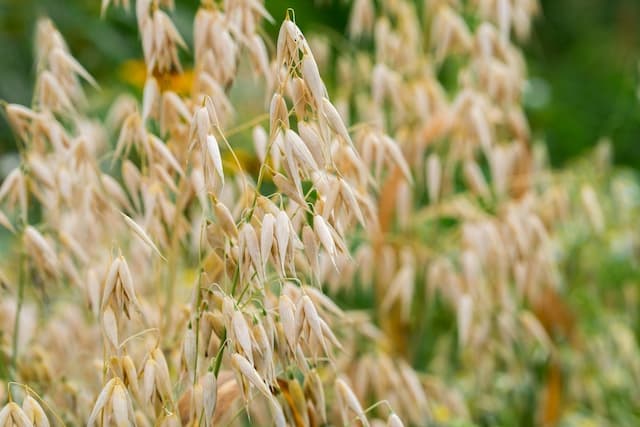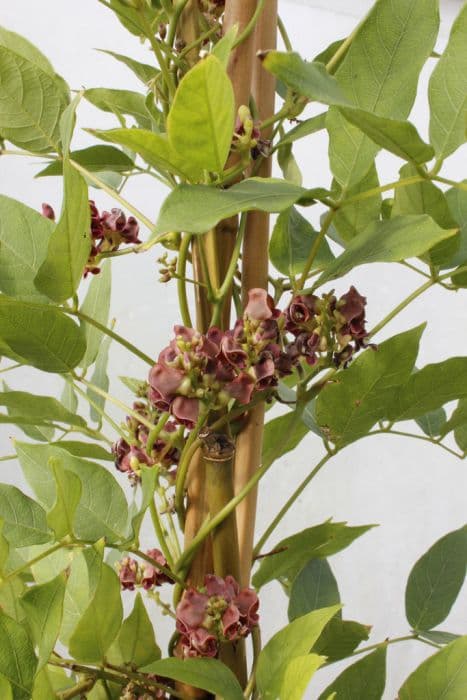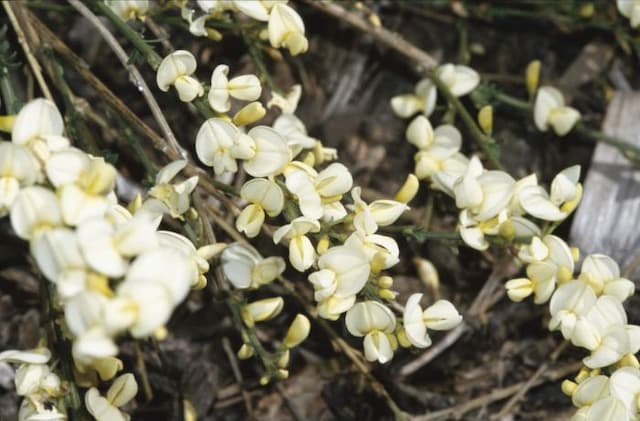Elegant Lupine Lupinus elegans 'Pink Fairy'

ABOUT
The Pink Fairy Lupine is a captivating plant known for its beautiful floral display and attractive foliage. The most striking feature of this plant is its stunning pink flowers that grow in dense, spike-like clusters, often referred to as racemes. Each individual flower resembles a small pea flower in shape, with a soft pink hue that may vary in intensity across the raceme. The blooms form a gradient of pink shades, adding to the plant's charm and making it stand out in any garden setting. The foliage of the Pink Fairy Lupine includes palmately compound leaves, which means each leaf is made up of multiple leaflets that radiate out from a single point like the fingers of a hand. The leaflets are typically bright green. Each leaf is arranged in a circular pattern, contributing to the plant's overall lush and full appearance. These leaves have a slightly soft texture and are known to add a delightful green contrast to the colorful flowers. The Pink Fairy Lupine, with its enchanting flowers and graceful leaves, creates a romantic and whimsical presence in the landscape.
About this plant
 Names
NamesFamily
Fabaceae
Synonyms
Elegant Lupine, Pink Fairy Lupine
Common names
Lupinus elegans.
 Toxicity
ToxicityTo humans
The plant known commonly as lupine is considered toxic to humans if ingested. The alkaloids present, such as lupinine and sparteine, can cause a range of symptoms, including lethargy, dizziness, rapid heartbeat, difficulty breathing, convulsions, and even coma. Severe poisoning can potentially be fatal, especially in children, who may be tempted by the colorful beans. Immediate medical attention should be sought if ingestion is suspected.
To pets
Lupine is also toxic to pets, including dogs and cats. The alkaloids it contains, especially in the seeds and pods, can cause symptoms similar to those in humans, such as vomiting, diarrhea, respiratory issues, and nervous system depression. In severe cases, it can result in liver damage and death. It is important to prevent pets from ingesting any part of the plant and to seek veterinary care immediately if poisoning is suspected.
 Characteristics
CharacteristicsLife cycle
Perennials
Foliage type
Deciduous
Color of leaves
Green
Flower color
Pink
Height
2-3 feet (0.6-0.9 meters)
Spread
1-2 feet (0.3-0.6 meters)
Plant type
Herb
Hardiness zones
4-8
Native area
Mexico
Benefits
 General Benefits
General Benefits- Attracts Pollinators: Lupinus elegans (known commonly as Lupine) draws bees, butterflies, and other beneficial insects, facilitating pollination of surrounding plants.
- Aesthetic Appeal: With its 'Pink Fairy' variety, it provides vibrant pink flowers that enhance the visual appeal of any garden or landscape.
- Nitrogen Fixation: As a legume, Lupine has the ability to fix atmospheric nitrogen into the soil, thus improving soil fertility and helping other plants to grow.
- Erosion Control: Lupine's extensive root system helps to stabilize soil and prevent erosion, particularly on slopes or in areas prone to soil degradation.
- Drought Tolerance: Once established, Lupine is relatively drought-tolerant, making it suitable for xeriscaping or in regions with lower water availability.
- Low Maintenance: It requires minimal care once established, other than occasional watering and the removal of spent flowers to encourage new blooms.
 Medical Properties
Medical PropertiesThis plant is not used for medical purposes.
 Air-purifying Qualities
Air-purifying QualitiesThis plant is not specifically known for air purifying qualities.
 Other Uses
Other Uses- The seeds of the Lupine can be made into a flour alternative after a special treatment to remove alkaloids, which can be used for various baking recipes for those looking to add variety to their diet.
- Lupine fibers have been traditionally used in some cultures to create strong textiles and ropes due to their durability.
- An extract from the Lupine's colorful petals can be used to create a natural dye for textiles, providing a range of pink hues.
- The fine, soft hairs found on Lupine leaves can be collected and used in the creation of natural brushes or as filling material for pillows and soft toys.
- Large Lupine leaves can serve as natural wrappers for foods during cooking, imparting a subtle, aromatic flavor and helping to retain moisture.
- The Lupus plant, owing to its nitrogen-fixing abilities, can be used in crop rotation to improve soil fertility and structure for future plantings.
- As an ornamental addition, dried Lupine stems and seed pods can be incorporated into flower arrangements and decorative displays.
- Lupine seeds are sometimes used in the creation of rattles and musical instruments for traditional folk music in some regions.
- Cultivated Lupine fields can provide substantial habitat and food sources for butterflies, bees, and other beneficial insects, supporting local biodiversity.
- The plant's deep root system can be employed in erosion control efforts, helping to stabilize soil and prevent landslides in vulnerable areas.
Interesting Facts
 Feng Shui
Feng ShuiThe Lupine is not used in Feng Shui practice.
 Zodiac Sign Compitability
Zodiac Sign CompitabilityThe Lupine is not used in astrology practice.
 Plant Symbolism
Plant Symbolism- Imagination: The Lupinus, commonly known as Lupine, often symbolizes imagination due to its vibrant and diverse colors, which can inspire creativity and fantasy.
- Innovation: Lupine's unique ability to fix nitrogen in the soil is a hallmark of innovation, representing the plant's role in transforming and rejuvenating the land.
- Devotion: In some traditions, Lupines are given as a symbol of devotion and dedication, expressing one's steadfastness and commitment.
 Water
WaterFor the Elegant Lupine, ensure the soil stays moist but not waterlogged. Water the plant deeply to encourage root growth, applying about 1 to 1.5 gallons of water per week, depending on weather conditions. During hot and dry periods, you may need to water the Elegant Lupine twice a week to maintain consistent soil moisture. Cut back on watering during rainy seasons or when temperatures are cooler to prevent overwatering. It's important to avoid overhead watering to prevent leaf diseases; instead, water directly at the base of the plant.
 Light
LightThe Elegant Lupine prefers full sunlight to thrive. It should be placed in a spot where it can receive at least 6 to 8 hours of direct sunlight daily. However, in extremely hot climates, some afternoon shade can be beneficial to prevent scorching. Avoid deep shade as it can lead to poor blooming and weak growth.
 Temperature
TemperatureElegant Lupines perform best in cooler conditions and can tolerate temperatures down to about 20 degrees Fahrenheit but may be damaged by severe frost. The ideal temperature range for the plant to thrive is between 60 and 75 degrees Fahrenheit. They struggle in extreme heat, so temperatures consistently above 85 degrees Fahrenheit may hinder their growth and flowering.
 Pruning
PruningPrune the Elegant Lupine primarily to remove spent flower spikes, which encourages a second bloom. Deadheading can be done throughout the blooming season as flowers fade. At the end of the growing season, or in late fall, cut back the foliage to the ground to keep the plant tidy and to help prevent disease. Pruning is not required frequently; once after the initial bloom and again at season's end is adequate.
 Cleaning
CleaningAs needed
 Soil
SoilElegant Lupine 'Pink Fairy' thrives best in a well-draining, slightly acidic to neutral soil mix, with an ideal pH range of 6.0 to 7.0. A mix containing loam, peat, and sand in equal parts provides the right balance of drainage and water retention.
 Repotting
RepottingElegant Lupine 'Pink Fairy' generally does not require frequent repotting and should be repotted every 2 to 3 years, or when it outgrows its current container.
 Humidity & Misting
Humidity & MistingElegant Lupine 'Pink Fairy' prefers moderate humidity levels, as too high humidity can encourage fungal diseases.
 Suitable locations
Suitable locationsIndoor
Elegant Lupine 'Pink Fairy' needs bright light and cool temps indoors.
Outdoor
Plant Elegant Lupine 'Pink Fairy' in full sun with good drainage.
Hardiness zone
4-8 USDA
 Life cycle
Life cycleBluebonnets, including Lupinus elegans 'Pink Fairy', begin their life cycle as seeds, which require stratification, a process of chilling to break dormancy before they germinate in late winter or early spring. Upon germination, they develop into seedlings with a pair of true leaves, before forming a rosette of leaves at the soil level. The plants subsequently grow upright stems and foliage, and in spring, they blossom with iconic pink flowers that attract pollinators. After the flowering phase, bluebonnets set seed in pods that mature by early to mid-summer. The pods eventually dry and burst open, scattering the seeds, which lie dormant until the next cycle. Over the course of the seasons, these plants can reseed themselves, completing their life cycle and ensuring the perpetuation of the species.
 Propogation
PropogationPropogation time
Spring-Early Summer
The Lupine 'Pink Fairy', known for its attractive spires of pink flowers, can be propagated through seed sowing. The best time to sow Lupine seeds is in spring, after the danger of frost has passed, or in late autumn, where winter cold can naturally stratify the seeds, which is crucial for their germination. To propagate, seeds are first scarified by lightly sanding the seed coat or soaking them in warm water overnight to soften the coat. Plant the seeds about a quarter of an inch deep (6mm) in well-draining soil, preferably in a sunny location. Germination usually takes about two to three weeks. Seedlings can be transplanted into the garden when they have produced several true leaves and there's no risk of frost.









